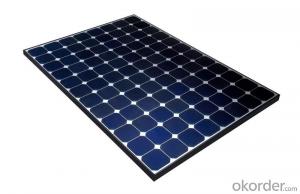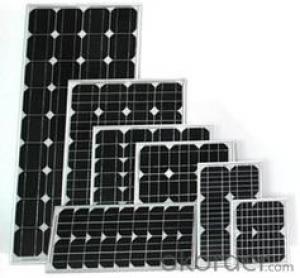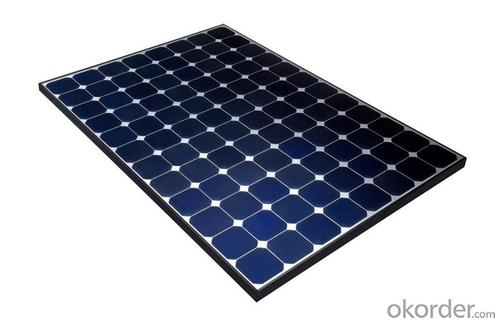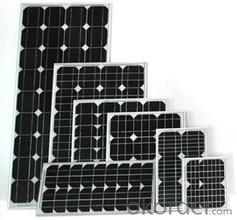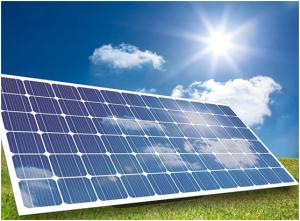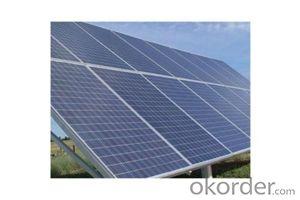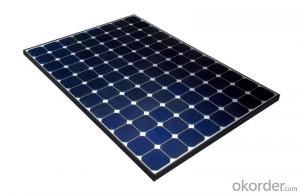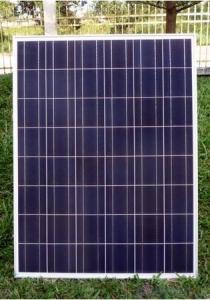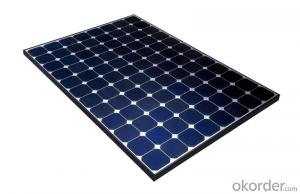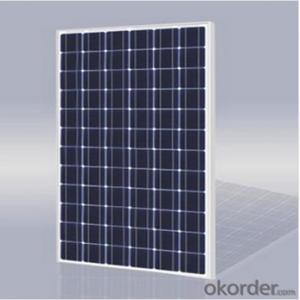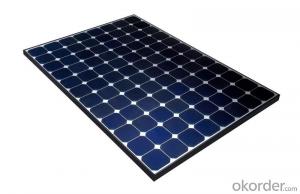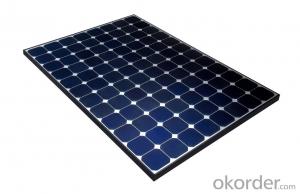Solar Panels for Home - CNBM Poly 225W Solar Panel with TUV UL CE Certificate for Residential
- Loading Port:
- Shanghai
- Payment Terms:
- TT OR LC
- Min Order Qty:
- 225 watt
- Supply Capability:
- 1000 watt/month
OKorder Service Pledge
OKorder Financial Service
You Might Also Like
Specification
CNBM Poly 225W Solar Panel with TUV UL CE Certificate For Residential
Introduction
Each module is rated by its DC output power under standard test conditions, and typically ranges from 100 to 365 watts. The efficiency of a module determines the area of a module given the same rated output – an 8% efficient 230 watt module will have twice the area of a 16% efficient 230 watt module. There are a few solar panels available that are exceeding 19% efficiency. A single solar module can produce only a limited amount of power; most installations contain multiple modules. A photovoltaic system typically includes a panel or an array of solar modules, a solar inverter, and sometimes a battery and/or solar tracker and interconnection wiring.
Micro-inverted solar panels are wired in parallel which produces more output than normal panels which are wired in series with the output of the series determined by the lowest performing panel (this is known as the "Christmas light effect"). Micro-inverters work independently so each panel contributes its maximum possible output given the available sunlight.[6
A solar cell, or photovoltaic cell (in very early days also termed "solar battery"[1]– a denotation which nowadays has a totally different meaning, see here), is an electrical device that converts the energy of light directly into electricity by thephotovoltaic effect, which is a physical and chemical phenomenon.[2] It is a form of photoelectric cell, defined as a device whose electrical characteristics, such as current, voltage, or resistance, vary when exposed to light. Solar cells are the building blocks of photovoltaic modules, otherwise known as solar panels.
Solar cells are described as being photovoltaic irrespective of whether the source issunlight or an artificial light. They are used as a photodetector (for example infrared detectors), detecting light or other electromagnetic radiation near the visible range, or measuring light intensity.
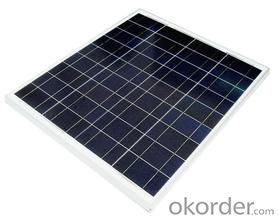
Suggested application
Home lighting business lighting,
Garden lighting, pavement lighting
Farmer household lighting
Decorative water pump
Traffic signal lighting
Industry area
Business area
Solar Power Plant
Product feature
Modules are made of Monocrystalline or Polycrystalline Silicon cell.
Materials and color of the solar panel frame: Clear anodized aluminum alloy type 6063T5 Universal frame; Silver-white color;
The output connection gathers the coupling: Selects conforms to the IEC-612615; 2005, class II, IEC61730 international standard; Airtight waterproofing binding clamp;
Module seal structure: The surface is thick, the high diaphanous rate armored glass with solar cell board special-purpose 3.2mm becomes after the high temperature lamination craft. The back selects has waterproof and anti- aged performance fine TPT materials. The entire block battery board has, the waterproofing, the anti- aging airtight and so on the fine performance;
Power tolerance: +/-3%
Packaging
International standard cartons (according to the requirements of customers)
- Q: Can solar panels be used to power a hotel?
- Yes, solar panels can be used to power a hotel. By installing a sufficient number of solar panels, a hotel can generate a significant amount of electricity to meet its power needs. This not only helps to reduce energy costs but also promotes sustainability and environmental responsibility.
- Q: I jotted down some notes for my Technology and Architecture class and I'm trying to figure out what i meant when i said 'Treated with gases at extremely high temperatures.' I have NO idea what I was talking about :) Im trying to figure out if what I am talking about is about Silicon, Polychristaline, or a Solar Cell/Panel.
- Build okorder /
- Q: If a solar panel has a power rate of 80 Watts and efficiency of lets say 30%. Does that mean the maximum power this solar panel can generate is (30/00)*80=54 Watts or its just 80 Watts?
- Solar panels are tested in a lab that has a light the produces 000 watt/hrs per square meter. In these conditions your panel will produce 80 watt/hrs. If you would like to know what it does in really world conditions you have to find the sun-hours in your given area. A sun-hour is basically how many watt/hrs hit a square meter in a day. This number changes based on time of year, orientation, and temperature. Here in Fairbanks Alaska if the panel was at 90 degrees facing true south in October (.9 sun-hours) It would produce 80 X .9 X .8 (20% efficiency loss due to wires and controllers) it would produce 273.6 watt/hrs on average each day.
- Q: I'm doing a project for school and I'm a little confused about energy and solar panels. I'm looking to propose installation of solar panels to power the computer lab at my school. From what I've read a computer and monitor use roughly 350 watts per hour. I was looking at solar panels and it says they produce various wattage. For example, I was looking at one rated at 200 watts. Does that mean 200 watts in a day? Or per hour? Please help.
- The rating of a solar panel is a maximum continuous rating. A 200 Watt panel will give a maximum of 200 watts under ideal conditions. A computer and monitor use about 400 Watts. not per hour - watts is Volts * Amps and a measure of Power. In hour a computer and monitor uses 400 Watt hours (Wh). Wh is a measure of Energy. To power a lab of 0 computers you will need 0* 400 = 4000 Watts. To run this from solar panels through the day only you would need a 4000 Watt panel. Except - its cloudy, the sun is in the wrong place - many factors reduce the output. To be reasonably safe you would need about a 2000 Watt panel. Then you would need batteries to store power through dull periods AND a voltage converter to change from low voltage DC from the solar panels to the mains voltage for your computers.
- Q: Can I make a solar panel at home?How to make it?
- The first thing to understand is that there is nothing complex about a solar panel. It is nothing more than a collection of solar or PV cells on a board that is fitted to the most appropriate part of your home, generally on the roof. There are guides out there that teach you how to build a solar panel and a windmill for just $50, and it’s very easy to make. Best of all, you can save 70% or more on your energy bill, adding up to thousands of dollars each year in savings. I reviewed both free guides and paid guides and have come up with our top to Build your own solar panels.
- Q: How long does it take to recoup the cost of solar panels through energy savings?
- The time it takes to recoup the cost of solar panels through energy savings can vary depending on several factors such as the initial cost of the panels, the amount of energy they generate, and the cost of electricity in your area. On average, it can take anywhere from 5 to 20 years to recoup the upfront cost. However, it's important to note that solar panels have a lifespan of 25 to 30 years, so you can continue to benefit from energy savings long after recovering the initial investment.
- Q: I'm trying to charge rechargeable AA batteries with a solar panel. What gauge wire should I use to connect the panel to the batteries? I know I'm not going to have a lot of current going through so the wire size doesn't really matter. Can the wire be too thick thoShould I ugh? Should I use a diode to keep the batteries from overpowering the circuit? If so, what size diode? My panel is 4.8V 50mA. Can I just hook the panel straight into the batteries or do I need something else?
- In order: .? Just about any wire will do.? You can handle 50 mA over just about anything, even 28 gauge telephone wire.? Your biggest problems are probably going to be mechanical stress (you want stranded wire instead of solid, to avoid breakage) and dealing with the size of larger wires. 8 gauge speaker wire may be a good optimum. 2.? You need a diode.? If you're charging NiMH or NiCd cells you're going to have about .25 volts/cell; you can charge up to 3 of them in series with a 4.8 volt panel.? The solar panel is a bunch of diodes itself, but they're leaky in the reverse direction; the diode prevents the batteries from discharging themselves back through the panel.? You want a Schottky-barrier diode, because the forward voltage drop is about 0.2 volts instead of 0.7 volts for a regular silicon rectifier.? This gives you maximum current output from your panel.
- Q: How do solar panels and heaters work?
- the cells inside the solar panels absorb the suns energy using it to heat water which generates steam and makes the generator go round and round like a windmill therefore producing energy
- Q: My plans are building several solar panels and have a battery bank. I want to be able to power the refriderator and freezer and occationaly an electric grill. How would This work exactly and what would the best way to hook this up to make it work? I want to be able to convert DC to AC. How many batterys would I need to make this work. I know when Civil unrest happens I want to be prepared. How would Wind Power work If I can get the equipment I need?
- lets find out
- Q: name things someone could use solar panels for or make with solar panels? (use solar energy i mean?)
- All depends on how many watts you have. I ran a small boom box off a 5w panel before with no problem. The higher the wattage, the more you can run.
Send your message to us
Solar Panels for Home - CNBM Poly 225W Solar Panel with TUV UL CE Certificate for Residential
- Loading Port:
- Shanghai
- Payment Terms:
- TT OR LC
- Min Order Qty:
- 225 watt
- Supply Capability:
- 1000 watt/month
OKorder Service Pledge
OKorder Financial Service
Similar products
Hot products
Hot Searches
Related keywords
